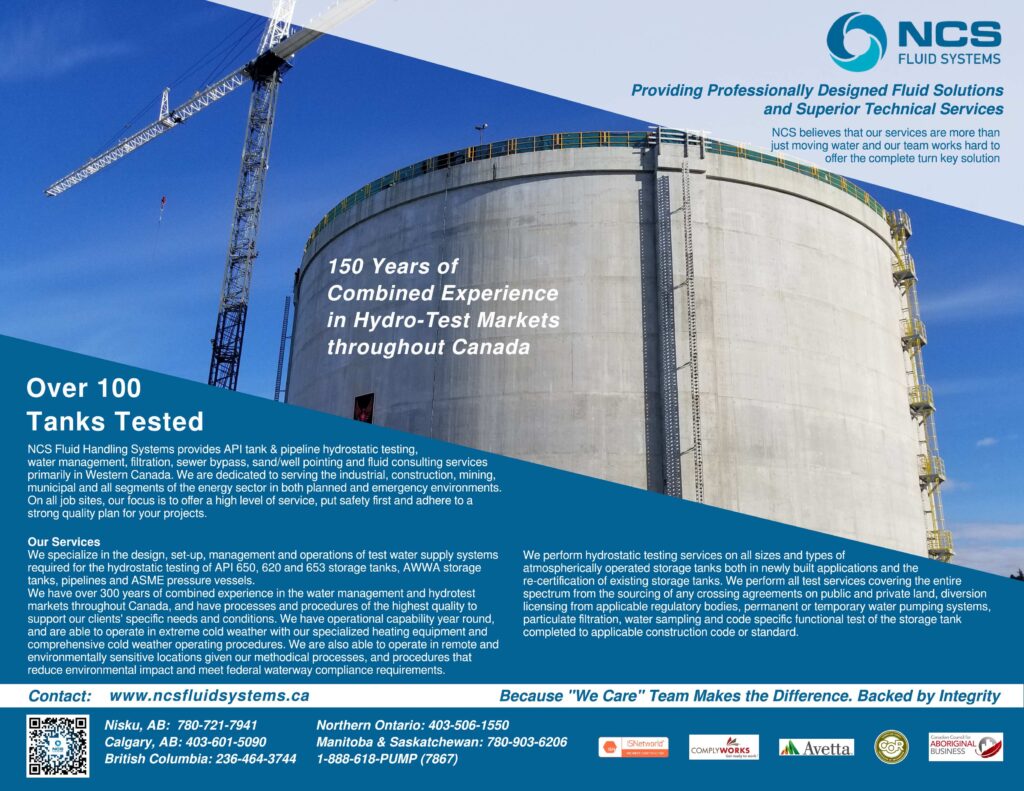Hydro testing and API 650
A common misunderstanding in the market is the purpose of Hydro-Testing or also known as Hydrostatic testing of new built API storage tanks. The belief that the hydro-test on a new built API 650 tank is just a leak tight test or that hydro-testing is important to do for settlement measurement. Both are partially correct. This blog will aim to demonstrate clarity around a full understanding of what is involved in Hydrostatic testing a new built tank.
This article will discuss how hydro testing is not just simply water transfer. When done by experienced designers and specialists a hydrostatic test can be made to suit several types of tank(s),services, testing of components and the elements of a tank that are evaluated when hydro testing is performed completely and properly.
Without getting to involved in specific risk management guidelines in specific end users’ and owners’ specifications or considering the exemptions or the waivers that are granted within the body of the API-650 Standard the following are quite simply summarized that “the main reasons for Hydro testing a new built tank are”:
Confirm that the tank is leak free and tight, nozzles, manways, shell seams, attachments etc.
In the event a pontoon style floating roof is installed, confirm pontoons are leak free and manway access operational.
Confirm weld integrity is suitable to withstand operational conditions
Allow for confirmation of uniform settlement on the tank base.
Perform full functional test of all working components of the tank accessories
Check rolling roof stairways for full range of operation and self leveling functional test
Floating roof drain range of operation, floating roof range of operation.
Floating roof seal may be installed & anti rotation devices etc.
Testing summary
Hydro testing demonstrates a tanks fitness for service by providing an integrity test. This test minimizes the risk of catastrophic failure, by using test conditions that replicates operational conditions using test medium (water) with a specific gravity greater than the designed cargo. Therefore, this hydrostatic test subjects the tank to a harsher condition than the tank would see during normal operation.
Also a hydrostatic test situation for items such as, uplift test of anchor bolts and chairs as well when tanks are designed for elevated internal pressures. (lower than those in a API- 620). In situations where a tank is designed to operate in a seismic zone, tests for uplift can be confirmed.
A tank may be designed to operate at a small internal pressure. At less than 2.5 PSI (above 2.5 PSI API-620 applies). Or when the internal pressure does not exceed the weight of the roof plates and additional test is performed. These tanks must be tested with water 51 mm or 2 inches above the top angle and a vacuum box test of all roof seams / welds is performed.
Caution must be used when conducting the following test condition and strict operating test procedures must be followed. The code does allow test some pneumatic test procedures. Where design pressure exceeds the weight of the roof plates and additional pneumatic test of 1.25 times design pressure can be added.
This procedure is typically used on tanks having anchor bolts and chairs to test uplift as well avoid deflection of tank shell to bottom over pressurization and bottom deflection.
It is not recommended that the cargo be used to hold the tank done as the shell to floor weld joint is still under stress which is not the preferential joint of failure.
Many tank terminal owners do take the hydro testing portion of the tank out of the contract. Testing may be left in the scope of the tank constructor, who elect to perform the hydrostatic test portion under subcontract to specialists such as NCS Fluid Handling Systems.
The team at NCS Fluid Handling Systems take the training and education of what a full Hydro test really is quite seriously, They provide training sessions through various forums such as lunch and learns and in classroom setting.
We believe that through an ongoing education at the customer level we can help those designing or evaluating testing requirements to understand the whole process, not just water management or transfer. Considering a few relatively simple requirements that do not add significant overall project expense NCS can provide comfort that operational risk is minimized, and asset integrity is maximized. Hydrotesting team shortcut or API Codes



